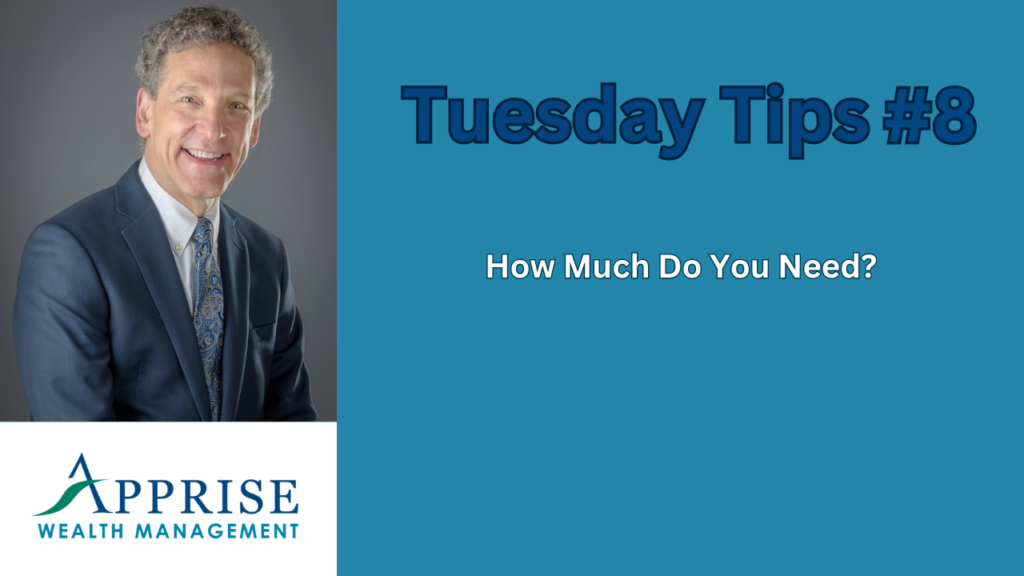This week’s Tuesday Tip addresses the question, “How much do you need?” and its connection to your investments. Please watch the video below to learn more. If you would like a free review of your current financial situation, please use this link to schedule a free call. You can find an edited transcript below the video.
How much do you need?
When you invest, how much do you need?
For what? How much do you need to retire? Or how much do you need to live your most fulfilled life? How much do you need to do what matters most to you?
These are not simple questions to answer, and they’re made even more complicated when you look at the market. Until last week we had five straight weeks of down markets. Clients do not often ask me much about what’s going on in the markets or question performance, but I have gotten a couple of questions recently about the markets.
I put in the below chart to help you see how the market has performed this century. You can see lots of dips along the way, but over the long haul, the market’s gone much higher.
This chart goes back to the end of 1999 the beginning of 2000, so this century.
Volatility can be tough to take, too. That’s why we have to take a long-term approach. Again, how much do you need?
I had a client reach out to me a few months ago when I shared my life plan. She said to me “Phil thank you for the message. I’ve always been sitting here trying to build the biggest pile of money, but never thinking about what was that money for, what did I want to do with it?”
After working on her life plan, she has much greater clarity around what matters to her most and what that money is for, and that gave her the confidence to make some changes that are visible. When I look at her and I talk to her I can see the changes that have been brought about since she’s made these changes.
Investing and Achieving Your Goals
When we invest, it’s about investing to achieve our goals. Down markets can create opportunity. Think about it this way: what would happen if you were buying shares of a fund or ETF that was $100 per share – let’s say it was an S&P 500 ETF – and the market fell by 25%? Your shares would be worth $75. But, if you kept buying, when the market comes back and historically when we’ve had market declines, it has come back. If the market recovers from 75 to 100 that’s a 33% gain. If you did nothing, you wouldn’t have any of those gains. The shares that you had that you bought at $100 are back to even, but the ones that you bought at $75 are now up 33%. So you benefited by buying during the downturn.
We want to keep buying. Think about this. When we invest, we’re making a long-term assumption, an implicit assumption, that the market’s overall direction is going to be up over the long term. That’s why we want to keep buying when we have down markets.
We can’t time the market with any level of success, so trying to get in and out just makes us have to make more decisions and increases our chances of being wrong. If I sell because I think the market is going to fall, I don’t know when to get back in. Am I going to be able to get it right in terms of when to get out and when to get it back in? Probably not.
We want to think about if we’re investing to achieve our goals.
How Much Do You Need?
How much do you need? You need enough to live your desired lifestyle now and in the future.
Remember that you don’t have to build the biggest pile of money. You just need enough to be able to do what you want to do. The focus should be on your goals and how to achieve them. You want to ignore the noise, too.
It can be dangerous watching a lot of financial media and a lot of financial news because, on a daily basis, the market probably goes down more than it goes up I believe it’s about 54% of the time the market goes down, but yet over the long term those up days are bigger than the down days and we end up with positive returns. The longer the time frame you look at the more likely you are to see a positive market return.
If you only looked at the market once a year, you would see it went up about two-thirds of the time. Now that could be really hard, but there are people who do what I’m saying. They say I’m just going to put it in a drawer and not look. Maybe you don’t want to do that, but the point is that if you take that long-term perspective, you’re going to feel a lot more comfortable.
When we have a down market remember, “This too shall pass.”
When you think about investing, think about, “How much do you need?” to live your desired lifestyle.
Don’t worry about building that biggest pile of money. Make sure that you can do what you want to do. Invest that way and don’t get worried about the noise.
Remember that unless you’re in retirement when the market falls it creates opportunity. You can still invest more, and you can still grow your portfolio.
When you’re in retirement there are steps that we can take to try to protect you and insulate you more from a market downturn, but they’re going to happen. They happen about one out of every three years on average.
I hope you find this helpful. I’ll be back again next week with Apprise’s “Five Favorite Reads of the Week.” Have a great day.
Our practice continues to benefit from referrals from our clients and friends. Thank you for your trust and confidence.
If you would like to talk to us about financial topics including your investments, creating your life plan, saving for college, or saving for retirement, please complete our contact form or schedule a call or a virtual meeting via Zoom. We will be in touch.
Follow us:
Please note. We post information about articles we think can help you make better money-related decisions on LinkedIn and Facebook.
For firm disclosures, see here: https://apprisewealth.com/disclosures/






